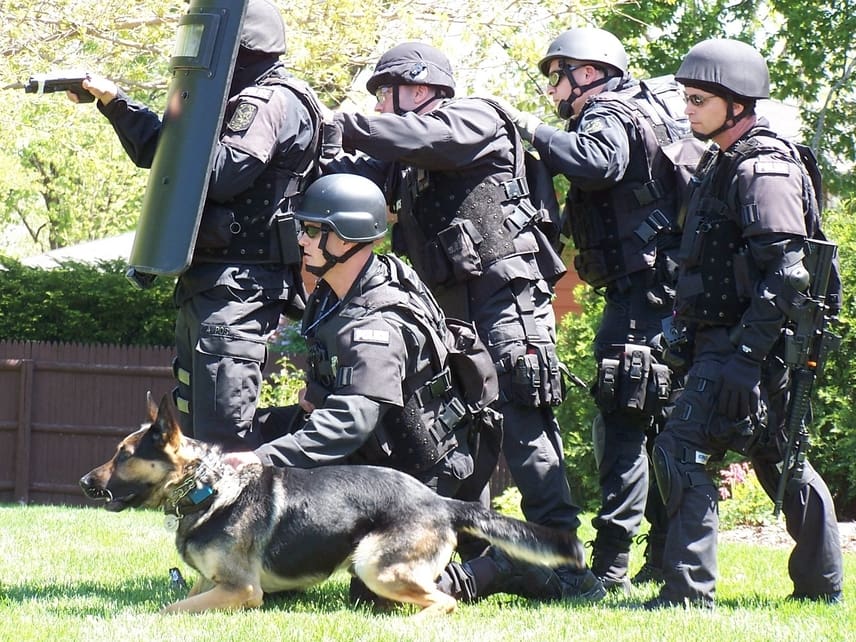Gun Violence Restraining Orders Could Cause More Police Shootings
Unless crafted carefully, the proposal could set up more standoffs between armed citizens and police.

In the wake of the mass shooting in Parkland, Florida, some conservative commentators—and a handful of libertarians—have proposed a measure they say would help disarm potential killers while respecting the Second Amendment rights of the general public: Gun Violence Restraining Orders, or GVROs.
The general idea is to enable the relatives or friends of a potentially violent person to petition a judge for a civil order temporarily suspending that person's ability to purchase or possess firearms. Like other restraining orders, they could be contested by the restrainee, with the petitioning party bearing the burden of proof.
Since they're individualized and judicial, GVROs avoid the "collective punishment" of gun prohibition and, if crafted well, will respect due process. You can see why they might appeal to civil libertarians. But there's a potential problem here too, arising from the way restraining orders work in practice.
I used to work at D.C.'s local courthouse, where I saw judges issue dozens of domestic violence restraining orders. Typically, a person seeking one comes to court on a walk-in basis and appears before a judge within an hour or so. The defendant is usually absent. If the petitioner presents sufficient evidence of threats, stalking, or prior assault (a sworn statement combined with text messages, photos, or bruises is usually enough) the court will issue a the temporary order without ever having heard from the defendant.
This procedure makes good sense. Restraining orders are meant to address imminent threats, so it would be silly to force the petitioner to notify their stalker and then wait around several days for a court date. But long-term restraints on a person's free movement require more than a mere allegation. So these "stay away" orders issued in absentia are limited and short-term. Usually they just tell the restrainee to not interact with the petitioner and to show up in court a few days later, where the judge can hear evidence from both sides and impose the appropriate longer-term restraint, if any.
Once issued, these temporary orders have to be served on the person they restrain before they take legal effect. That ensures that the restrainees have actual notice that they've been restrained and have been told what it is they're now banned from doing.
This is where the trouble starts for GVROs. Presumably, the process for obtaining GVROs would be substantially similar—it would have to be, given that they also need to address imminent, not speculative, threats.
But think of the situation that arises once a temporary GVRO has been issued in absentia and needs to be served. Someone now has to knock on the door of (or otherwise track down) a person who is known to be armed and alleged to be dangerous, serve that person with court documents, and then take away whatever guns the person already has.
Domestic violence restraining orders are sometimes served by police officers, but can also be delivered by any adult who is not the petitioner. It's a tricky enough business as it is, given that restrainees do not tend to be the calmest and politest members of society. Throw guns into the mix, and things get even dicier. There would be a strong impulse to mandate that the orders be served by police officers. The officers, in turn, would be understandably tempted to bring heavy armor and firepower along with them when serving the order.
Cops, understandably, don't like knocking on doors when all they know is that there's an angry person with a gun on the other side. Ask them to serve GVROs, and you'd likely see an explosion in the number of paramilitary-style no-knock SWAT raids and the associated police shootings that some portion of them inevitably cause.
Civil libertarians have worked for years trying to curtail these aggressive police tactics and the chaos they produce. If implemented carelessly, GVRO laws could increase the number of these raids. To avoid that, a GVRO law would have to include specific procedures for how the orders should be served, and for how the restrainee should be deprived of guns he already owns without needless violence.
The order could simply be served like other court papers, providing a window for restrainees to surrender firearms within a certain time, only involving police in the event of non-compliance. Police who serve GVROs could be required to wear plain clothes and effect service on a knock-and-talk basis to keep the restrainees from feeling provoked. There are probably other workable solutions, too.
A great example of how not to implement GVROs can be seen, perhaps not surprisingly, in Congress, where a proposed bill does a terrible job of protecting due process. Running afoul of all the concerns about GVROs articulated by Reason's Jacob Sullum, the proposal sets the standard of proof for issuing orders at the very low "reasonable suspicion" level, the same "slightly more than a hunch" standard used for "stop and frisk" searches—even less certainty than is needed to obtain a search warrant. The bill at least provides for a hearing within 30 days, but in practice an asserted "reasonable suspicion" is almost impossible to disprove.
Just as significantly, the bill sets out no guidance on how to serve GVROs or carry out gun seizures without prompting violent confrontations.
If advocates are going to propose GVROs as a serious way to address mass shootings while respecting liberty, they need to think carefully about the details of what they're suggesting and the likely consequences. Congress has so far failed to do that, tearing ahead instead with a poorly crafted bill that might cause more shootings than it stops.